► VW Golf 1974-2024: a history
► Story behind the enduring hatch
► A look back at 50 years old
The Volkswagen Golf. It’s been with us for half a century now and has touched the lives of hundreds of millions of people. In an industry where style often matters more than substance, the original Golf was a paragon of product design, a car whose usefulness made it ubiquitous. And through eight generations it has remained the definitive compact hatchback, the car against which all comers in the segment, old and new, are invariably judged.
Today’s Golf is of course bigger, heavier, more powerful and more complex than the original. But its DNA is unmistakable. As it has always been. ‘What’s it like?’ a journalist asked Bernd Pischetsrieder when in 2003 he revealed he had been driving pre-production versions of the forthcoming Mk5 Golf. The question momentarily flummoxed the Volkswagen Group chairman. ‘It’s like a Golf,’ he replied. There was nothing more that needed to be said.
More than 37 million Golfs have been built since 1974. Yes, Toyota has built more than 50 million Corollas, making it the most successful name plate in history. But unlike the Toyota Corolla, which was launched as a rear-wheel-drive small car in 1966 before switching to front-wheel drive in 1983, today’s Golf is built to the same template as the original. Though compact SUVs are now the world’s most popular vehicle format, the Golf still looms large in a segment that in 2022 accounted for almost 1.4 million sales worldwide.
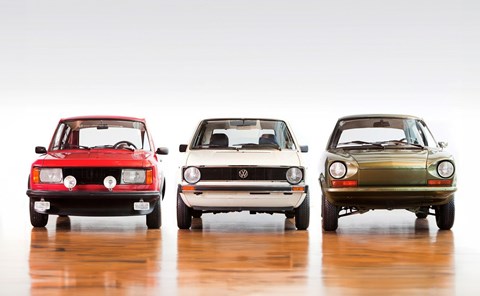
It is tempting to regard the Golf (pictured above with two rival design concepts) as the inevitable follow-up to the Beetle, the car the entire Volkswagen enterprise was created to build, and whose own usefulness and ubiquity enabled it to defy industry convention for decades. But it’s not that simple.
Before the Golf, Volkswagen was a company trapped in its own history. ‘What happens if the Americans stop being amused by the Beetle?’ said West German finance minister Franz Josef Strauß in 1967, articulating Volkswagen’s fatal flaw.
VW Golf: a rapid sales success, as customers fell for its modernist charms
Sales in Germany had slumped from 600,000 vehicles in 1965 to 370,000, and 40 per cent of all Beetles were being sold in the United States, where its combination of low price, solid durability and quirky personality made it a hit among newly minted middle-class suburban men who could afford a second car for their wives or their college-age kids. VW was being kept alive by the Beetle’s success as a niche product in a single market.
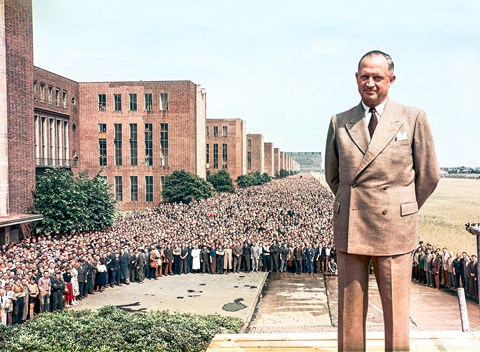
Under Heinrich Nordhoff (above), the hard-nosed micromanager with a gift for self-promotion who had run the company since 1948, virtually all the prototypes Volkswagen developed as potential Beetle replacements had been little more than rebodied Beetles, right down to their rear-mounted, air-cooled, four-cylinder boxer engines; ’50s and ’60s riffs on a vehicle concept designed in the 1930s.
Serious work on alternatives with water-cooled engines – front-engine/rear-wheel drive, front-engine/front-wheel drive and even with an engine mounted under the rear seat and driving the rear wheels – did not start until after Nordhoff died in 1968.
The design genius of Giugiaro
In the autumn of 1969, as engineers in Wolfsburg struggled to re-imagine a people’s car for the space age, Nordhoff’s successor, Kurt Lotz, and VW’s Italian importer, Gerhard Gumpert, visited the Turin motor show. Comparing notes, they discovered that four of their six favourite cars had been designed by a 31-year-old who had established his own independent design business just 18 months earlier. His name was Giorgetto Giugiaro. Lotz invited the young Italian to Wolfsburg.
When Giugiaro arrived at the Volkswagen Research Centre on a frigid morning in January 1970, he was taken into a giant room. There, laid out on the floor, was a carefully dismantled and sectioned Fiat 128 (below), the compact front-wheel-drive saloon launched just 10 months earlier. ‘The 128 was the reference car,’ Giugiaro confirmed in a 2002 interview with la Repubblica journalist Vincenzo Borgomeo. The Fiat defined the basic package and layout of what would become the Mk1 Golf.
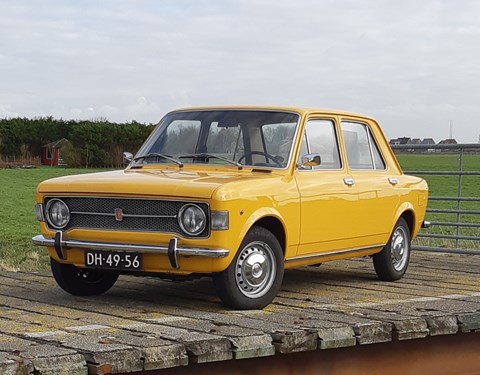
Giugiaro’s original Golf design had a shorter bonnet and a more raked windscreen. These were changed for the production car because of concerns over meeting US crash and interior-reflection regulations. It also had rectangular headlights, but these were switched to round units to cut costs. Giugiaro was not happy. ‘I objected, I protested,’ he told Borgomeo. ‘I even said that [from the front] the Golf… looked too much like the Alfa Romeo Giulia GT. Do you know what they replied to me? “If it looks like an Alfa, it’s better that way.”’
Launched in May 1974, the Golf proved an instant hit. It had taken Volkswagen nine years to produce and sell a million Beetles. Golf sales topped a million within two years. Propelled by the Golf, Volkswagen posted a staggering profit of DM1 billion in 1976, more than anyone in Wolfsburg could have imagined possible a few years earlier.
The millionth Golf was produced on 27 October 1976, just 31 months after launch (below). Toni Schmücker, a former Ford executive who in 1974 had become the third person to head troubled VW in the six years since Nordhoff’s death, described the turnaround as ‘almost incredible’.
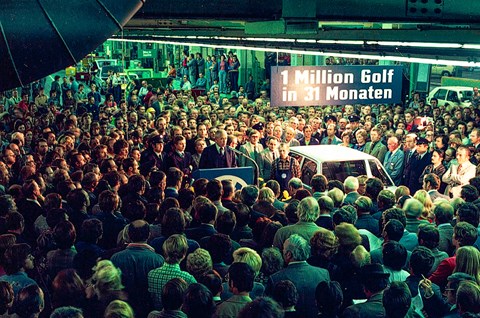
Compact yet roomy, frugal yet fun to drive, the Mk1 Golf effortlessly surfed the zeitgeist of the late 1970s. This unpretentious hatchback offered a quiet oasis of common sense in a world riven by oil crises, war and terrorism. It also provided the raw material for an idea that would reveal a hitherto unknown Volkswagen, a Volkswagen that could build real driver’s cars.
The genesis of the VW Golf GTI
In the autumn of 1974, Volkswagen’s press office chief, Anton Konrad, and VW test engineer Alfons Löwenberg, came up with an idea they called the Sport Golf. ‘The regular Golf had up to 85bhp, and my idea was to come up with a car with more power,’ Konrad, who died earlier this year, recalled in a 2016 interview. ‘We wanted a car to attract young people, and to make people more interested in motor racing. We wanted to give the car all the genes that are necessary in motorsports, but the car had to be used in the city, on the autobahn and for leisure.’
VW marketeer Horst-Dieter Schwittlinsky replaced the Sport Golf working title with a new name: Golf Grand Tourer Injection. The Golf GTI. And it was VW’s chief designer Herbert Schäfer, a keen golfer, who attached a golf ball to the GTI’s gearlever as the finishing touch.
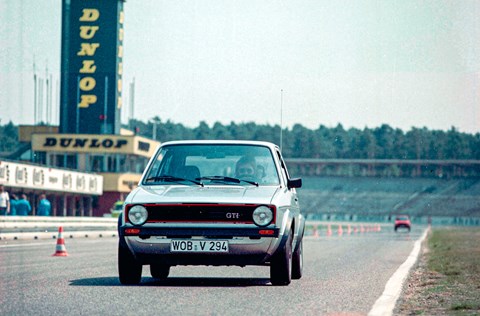
The Golf GTI was shown to the VW board in early 1975 and was officially greenlit for production on 28 May. Even then, Volkswagen’s still conservative senior management wasn’t entirely convinced. ‘The marketing department said we would only build 5000 examples, so set the price very high,’ Konrad said. ‘In the first year we sold 30,000, and by the end of the Mk1 we had sold 420,000. It was also a financial success. We were so happy we forgot to ask the bosses if we could each have one Deutsche Mark for each car sold!’
Fore! When Golf goes wrong…
As the Mk8 VW Golf revealed, with its glitchy software and poorly thought-out switchgear, not all Golfs have been created equal. ‘It was too slow, too average,’ was Bernd Pischetsrieder’s acerbic assessment of the Mk4 GTI when he spoke to CAR during the summer of 2004.
Made softer and flabbier than previous GTIs in a bid to broaden its appeal, the Mk4 also eschewed the red line graphic on the grille that had been a key GTI visual since the Mk1. ‘It was not a proper GTI,’ Pischetsrieder growled. ‘It was marketing gone wrong.’
But for other reasons the Mk4 is a highly significant Golf. It was the first to bear the fingerprints of Ferdinand Piëch, the iconoclastic engineer who was now VW’s autocratic and acquisitive CEO, and whose grandfather, Ferdinand Porsche, had designed the original Beetle. His grandfather’s car had democratised mobility. Piech’s Golf democratised luxury, especially inside, with an interior whose surfaces, colours and materials looked as if they’d been cribbed from a high-end Audi.
In terms of the non-GTI models the Mk4 was indisputably a Golf, a compact hatchback that was well engineered and solidly built. But it was now also something else: it was premium. It stood apart from its mainstream rivals from Ford and Opel, Peugeot and Renault.
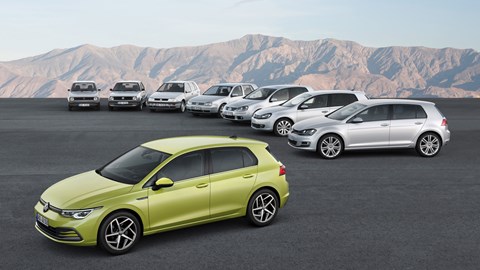
Engineer Ulrich Hackenberg oversaw the development of the Mk5, the Mk6, and the Mk7 Golfs. His cars are significant not so much for what you can see, but for what’s under the skin: the Mk5 was built on VW Group’s PQ35 platform, one of the key elements of Piëch’s cleverly orchestrated platform-sharing strategy. In addition to underpinning the Mk5 Golf, PQ35 would become a VW Group workhorse, used for vehicles of wildly different purpose and personality, ranging from the Audi TT to the Seat Leon, the Skoda Yeti and the Volkswagen Caddy.
The Mk7 Golf launched in 2012 is even more significant, as this debuted Hackenberg’s highly efficient and flexible modular vehicle ‘toolkit’ concept that is now used across all Volkswagen Group model lines, from Skoda to Bentley. Hackenberg describes the Mk7 Golf as his masterpiece. ‘All of my knowledge went into the Mk7,’ he says.
Scale, platform-sharing and the business behind great Golf
Because the ‘toolkit’ used to build the Mk7 – the Modularer Querbaukasten, aka MQB – comprised parts and components that could also see duty on models such as the Passat and various SUVs, the Mk7 was, in Hackenberg’s opinion, the most over-engineered Golf in history. ‘Instead of specifically engineering lower-cost parts for the Golf, it made sense to bring the cost of those parts down through higher volume,’ he explains. Many of those parts, of course, have been carried over to the Golf Mk8 and Mk8.5.
‘The Golf is a car where you are not allowed to make big mistakes,’ smiles Ulrich Hackenberg. He’s no stranger to shouldering the burden of history that rides along with the development of every new Golf. But, he says, with the Golf the perfect need not be the enemy of the good: ‘You want to be the best, but you need not be the best in all categories. You need to be the best in general.’
That is perhaps the key to the Golf’s enduring appeal: it has never been anything less than a competent all-rounder, the rational choice in the segment. Ferdinand Porsche’s Beetle was widely seen as a stunningly original creation, although in truth he had appropriated many of the car’s innovative concepts from others, most notably the talented Josef Ganz, a Jewish engineer from Frankfurt who was forced to flee Germany in 1934, as well as Hungarian inventor and later Mercedes-Benz safety pioneer Béla Barényi, who in 1925 had filed technical drawings for a remarkably similar car.
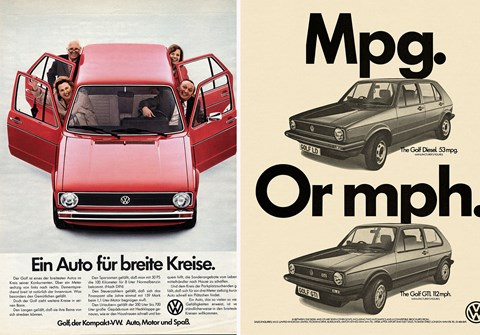
The Golf, by contrast, broke no new ground when it was launched. Its overall size and engineering layout was heavily influenced by Fiat’s 128, a car designed by the legendary Dante Giacosa, the man responsible for the tiny and brilliant Fiat 500.
Even the decision to make the Golf a hatchback, 50 years on still the definitive compact-car format, wasn’t entirely an a-ha! moment: the idea had been introduced to the mass market with the 1961 Renault 4, and first combined with a transverse front-engine layout like the Golf’s in the 1967 Simca 1100. And it could be argued that the GTI, the seminal hot hatch, was simply a factory hot rod in the spirit of the original Mini Cooper and Cooper S.
Viewed dispassionately, the Volkswagen Golf is thus perhaps an ordinary thing. But there is excellence in doing ordinary things extraordinarily well. And that’s why, after 50 years, the Golf is still with us.